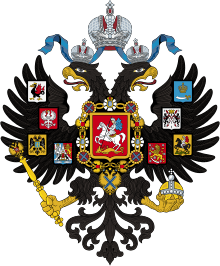Ivan the Terrible
| Ivan the Terrible | |||||
|---|---|---|---|---|---|
 Forensic facial reconstruction of Ivan IV by Mikhail Gerasimov[1] | |||||
| Tsar of All Rus' | |||||
| Reign | 16 January 1547 – 28 March 1584 | ||||
| Coronation | 16 January 1547 | ||||
| Predecessor |
Himself as Grand Prince of Moscow | ||||
| Successor | Feodor I | ||||
| Grand Prince of Moscow | |||||
| Reign | 3 December 1533 – 16 January 1547 | ||||
| Predecessor | Vasili III | ||||
| Successor |
Himself as Tsar of Russia | ||||
| Born |
25 August 1530 Kolomenskoye, Grand Duchy of Moscow | ||||
| Died |
28 March [O.S. 18 March] 1584 (aged 53) Moscow, Tsardom of Russia | ||||
| Burial | Cathedral of the Archangel, Moscow | ||||
| Spouses | |||||
| Issue more... | |||||
| |||||
| Dynasty | Rurik | ||||
| Father | Vasili III of Russia | ||||
| Mother | Elena Glinskaya | ||||
| Religion | Russian Orthodox | ||||
Ivan IV Vasilyevich (Russian: Ива́н Васи́льевич, tr. Ivan Vasilyevich; 25 August 1530 – 28 March [O.S. 18 March] 1584),[2] commonly known as Ivan the Terrible or Ivan the Fearsome (Russian: ![]()
During his reign, Russia conquered the Khanates of Kazan, Astrakhan and Sibir, becoming a multiethnic and multicontinental state spanning approximately 4,050,000 km2 (1,560,000 sq mi). He exercised autocratic control over Russia's hereditary nobility and developed a bureaucracy to administer the new territories. He transformed Russia from a medieval state into an empire, though at immense cost to its people, and its broader, long-term economy.
Historic sources present disparate accounts of Ivan's complex personality: he was described as intelligent and devout, given to rages and prone to episodic outbreaks of mental instability[3] that increased with his age.[4][5] In one such outburst, he killed his son and heir Ivan Ivanovich after also killing the latter's unborn son. This left his younger son, the pious and politically ineffectual Feodor Ivanovich, to inherit the throne. This later directly led to the end of the Rurikid dynasty as well as the beginning of the Time of Troubles, as Feodor was unable to produce an heir.
Ivan was an able diplomat, a patron of arts and trade, and founder of the Moscow Print Yard, Russia's first publishing house. He was popular among Russia's commoners (see Ivan the Terrible in Russian folklore), except for the people of Novgorod and surrounding areas (see "Massacre of Novgorod"), and he is also noted for his paranoia and harsh treatment of the Russian nobility.
Sobriquet
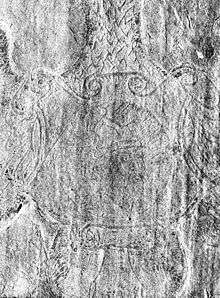
The English word terrible is usually used to translate the Russian word grozny in Ivan's nickname, but this is a somewhat archaic translation. The Russian word grozny reflects the older English usage of terrible as in "inspiring fear or terror; dangerous; powerful; formidable". It does not convey the more modern connotations of English terrible, such as "defective" or "evil". Vladimir Dal defines grozny specifically in archaic usage and as an epithet for tsars: "courageous, magnificent, magisterial and keeping enemies in fear, but people in obedience".[6] Other translations have also been suggested by modern scholars.[7][8][9]
Early life
Ivan was the first son of Vasili III and his second wife, Elena Glinskaya, who was of half Serbian and half Lipka Tatar descent,[10] the Glinski clan (nobles based in the Grand Duchy of Lithuania) claiming descent from the Mongol ruler Mamai (1335-1380.)[11][12] When Ivan was three years old, his father died from an abscess and inflammation on his leg that developed into blood poisoning. Ivan was proclaimed the Grand Prince of Moscow at the request of his father. His mother Elena Glinskaya initially acted as regent, but she died of what many believe to be assassination by poison,[13][14] in 1538 when Ivan was only eight years old. The regency then alternated between several feuding boyar families fighting for control. According to his own letters, Ivan, along with his younger brother Yuri, often felt neglected and offended by the mighty boyars from the Shuisky and Belsky families. In a letter to Prince Kurbski Ivan remembers, "My brother Iurii, of blessed memory, and me they brought up like vagrants and children of the poorest. What have I suffered for want of garments and food!![15]" It should be noted, however, that the historian Edward L Keenan has presented compelling reasons to doubt the authenticity of the source in which these quotes are found.[16]
On 16 January 1547, at age sixteen, Ivan was crowned with Monomakh's Cap at the Cathedral of the Dormition. He was the first to be crowned as "Tsar of All the Russias", hence claiming the ancestry of Kievan Rus'. Prior to that, rulers of Muscovy were crowned as Grand Princes, although Ivan III the Great, his grandfather, styled himself "tsar" in his correspondence. Two weeks after his coronation, Ivan married his first wife Anastasia Romanovna, a member of the Romanov family, who became the first Russian tsaritsa.
By being crowned Tsar, Ivan was sending a message to the world and to Russia: he was now the only supreme ruler of the country, and his will was not to be questioned. "The new title symbolized an assumption of powers equivalent and parallel to those held by former Byzantine Emperor and the Tatar Khan, both known in Russian sources as Tsar. The political effect was to elevate Ivan's position."[17] The new title not only secured the throne, but it also granted Ivan a new dimension of power, one intimately tied to religion. He was now a "divine" leader appointed to enact God's will, as "church texts described Old Testament kings as 'Tsars' and Christ as the Heavenly Tsar."[18] The newly appointed title was then passed on from generation to generation: "succeeding Muscovite rulers ... benefited from the divine nature of the power of the Russian monarch ... crystallized during Ivan's reign."[19]
Domestic policy
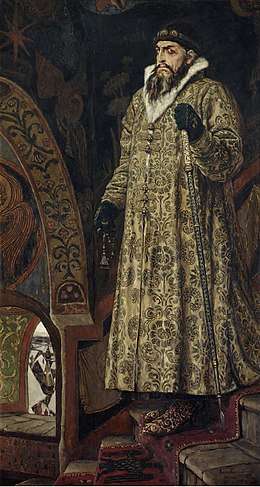
Despite calamities triggered by the Great Fire of 1547, the early part of Ivan's reign was one of peaceful reforms and modernization. Ivan revised the law code, creating the Sudebnik of 1550, founded a standing army (the streltsy),[20] established the Zemsky Sobor (the first Russian parliament of the feudal Estates type) and the council of the nobles (known as the Chosen Council), and confirmed the position of the Church with the Council of the Hundred Chapters (Stoglavy Synod), which unified the rituals and ecclesiastical regulations of the whole country. He introduced local self-government to rural regions, mainly in the northeast of Russia, populated by the state peasantry.
By Ivan's order in 1553 the Moscow Print Yard was established and the first printing press was introduced to Russia. Several religious books in Russian were printed during the 1550s and 1560s. The new technology provoked discontent among traditional scribes, leading to the Print Yard being burned in an arson attack. The first Russian printers, Ivan Fedorov and Pyotr Mstislavets, were forced to flee from Moscow to the Grand Duchy of Lithuania. Nevertheless, printing of books resumed from 1568 onwards, with Andronik Timofeevich Nevezha and his son Ivan now heading the Print Yard.
Ivan had St. Basil's Cathedral constructed in Moscow to commemorate the seizure of Kazan. There is a false legend that he was so impressed with the structure that he had the architect, Postnik Yakovlev, blinded so that he could never design anything as beautiful again. In reality, Postnik Yakovlev went on to design more churches for Ivan and the walls of the Kazan Kremlin in the early 1560s, as well as the chapel over St. Basil's grave that was added to St. Basil's Cathedral in 1588, several years after Ivan's death. Although more than one architect was associated with this name and constructions, it is believed that the principal architect is one and the same person.[21][22][23]
Other events of this period include the introduction of the first laws restricting the mobility of the peasants, which would eventually lead to serfdom, instituted during the rule of future tsar Boris Godunov in 1597.[24] (See also Serfdom in Russia.)
Oprichnina
The 1560s brought hardships to Russia that led to a dramatic change of Ivan's policies. Russia was devastated by a combination of drought and famine, unsuccessful wars against the Polish–Lithuanian Commonwealth, Tatar invasions and the sea-trading blockade carried out by the Swedes, Poles and the Hanseatic League. His first wife, Anastasia Romanovna, died in 1560, and her death was suspected to be a poisoning. This personal tragedy deeply hurt Ivan and it is thought to have affected his personality, if not his mental health. At the same time, one of Ivan's advisors, Prince Andrei Kurbsky, defected to the Lithuanians, took command of the Lithuanian troops and devastated the Russian region of Velikiye Luki. This series of treasons made Ivan paranoically suspicious of nobility.

On 3 December 1564, Ivan departed Moscow for Aleksandrova Sloboda. From there he sent two letters in which he announced his abdication because of the alleged embezzlement and treason of the aristocracy and clergy. The boyar court was unable to rule in Ivan's absence and feared the wrath of the Muscovite citizenry. A boyar envoy departed for Aleksandrova Sloboda to beg Ivan to return to the throne.[25][26] Ivan agreed to return on condition of being granted absolute power (see Absolute monarchy). He demanded that he should be able to execute and confiscate the estates of traitors without interference from the boyar council or church. Upon this, Ivan decreed the creation of the oprichnina.[27]
The oprichnina consisted of a separate territory within the borders of Russia, mostly in the territory of the former Novgorod Republic in the north. Ivan held exclusive power over the oprichnina territory. The Boyar Council ruled the zemshchina ('land'), the second division of the state. Ivan also recruited a personal guard known as the Oprichniki. Originally it was a thousand strong.[26][28] The oprichniki were headed by Malyuta Skuratov. One known oprichnik was the German adventurer Heinrich von Staden. The oprichniki enjoyed social and economic privileges under the oprichnina. They owed their allegiance and status to Ivan, not to heredity or local bonds.[26]
The first wave of persecutions targeted primarily the princely clans of Russia, notably the influential families of Suzdal. Ivan executed, exiled or forcibly tonsured prominent members of the boyar clans on questionable accusations of conspiracy. Among those executed were the Metropolitan Philip and the prominent warlord Alexander Gorbaty-Shuisky. In 1566 Ivan extended the oprichnina to eight central districts. Of the 12,000 nobles there, 570 became oprichniks, and the rest were expelled.[29]
Under the new political system, the Oprichniki were given large estates, but unlike the previous landlords, could not be held accountable for their actions. These men "took virtually all the peasants possessed, forcing them to pay 'in one year as much as [they] used to pay in ten.'"[30] This degree of oppression resulted in increasing cases of peasants fleeing, which in turn led to a drop in the overall production. The price of grain increased by a factor of ten.
Sack of Novgorod
Conditions under the Oprichnina were worsened by the 1570 epidemic, a plague that killed 10,000 people in Novgorod, and 600–1,000 daily in Moscow. During the grim conditions of the epidemic, and a famine along with the ongoing Livonian War, Ivan grew suspicious that noblemen of the wealthy city of Novgorod were planning to defect, placing the city itself into the control of the Grand Duchy of Lithuania. In 1570 Ivan ordered the Oprichniki to raid the city. The Oprichniki burned and pillaged Novgorod and the surrounding villages, and the city was never to regain its former prominence.[31]
Casualty figures vary greatly from different sources. The First Pskov Chronicle estimates the number of victims at 60,000.[31][32][33] According to the Third Novgorod Chronicle, the massacre lasted for five weeks. The massacre of Novgorod consisted of men, women and children that were tied to sleighs, then run into the freezing waters of the Volkhov River, which Ivan ordered on the basis of unproved accusations of treason. He then tortured its inhabitants and killed thousands in a pogrom; the archbishop was also hunted to death.[34] Almost every day 500 or 600 people were killed or drowned. Yet the official death toll named 1,500 of Novgorod's big people (nobility) and mentioned only about the same number of smaller people. Many modern researchers estimate the number of victims to range from 2,000–3,000 (after the famine and epidemics of the 1560s the population of Novgorod most likely did not exceed 10,000–20,000).[35] Many survivors were deported elsewhere.
The Oprichnina did not live long after the sack of Novgorod. During the 1571–72 Russo-Crimean war, oprichniks failed to prove themselves worthy against a regular army. In 1572, Ivan abolished the Oprichnina and disbanded his oprichniks.
Foreign policy
Diplomacy and trade
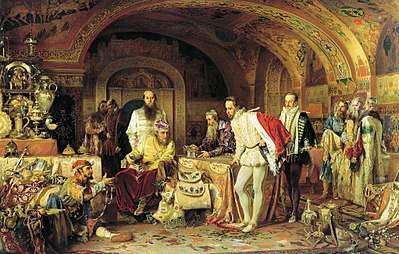
In 1547, Hans Schlitte, the agent of Ivan, recruited craftsmen in Germany for work in Russia. However, all these craftsmen were arrested in Lübeck at the request of Poland and Livonia. The German merchant companies ignored the new port built by Ivan on the River Narva in 1550 and continued to deliver goods in the Baltic ports owned by Livonia. Russia remained isolated from sea trade.
Ivan established close ties with the Kingdom of England. Russo-English relations can be traced to 1551, when the Muscovy Company was formed by Richard Chancellor, Sebastian Cabot, Sir Hugh Willoughby and several London merchants. In 1553, Richard Chancellor sailed to the White Sea and continued overland to Moscow, where he visited Ivan's court. Ivan opened up the White Sea and the port of Arkhangelsk to the Company and granted the Company privilege of trading throughout his reign without paying the standard customs fees.[36] Muscovy Company retained the monopoly in Russo-English trade until 1698.
With the use of English merchants, Ivan engaged in a long correspondence with Elizabeth I of England. While the queen focused on commerce, Ivan was more interested in a military alliance. During his troubled relations with the boyars, the tsar even asked her for a guarantee to be granted asylum in England should his rule be jeopardized. Elizabeth agreed on condition that he provided for himself during his stay.[37]
Ivan IV corresponded with overseas Orthodox leaders. In response to a letter of Patriarch Joachim of Alexandria asking the Tsar for financial assistance for the Saint Catherine's Monastery in the Sinai Peninsula, which had suffered from the Turks, Ivan IV sent in 1558 a delegation to Egypt Eyalet by archdeacon Gennady, who, however, died in Constantinople before he could reach Egypt. From then on the embassy was headed by Smolensk merchant Vasily Poznyakov. Poznyakov's delegation visited Alexandria, Cairo and Sinai, brought the patriarch a fur coat and an icon sent by the Tsar and left an interesting account of its 2½ years of travels.[38]
Conquest of Kazan and Astrakhan
.jpeg)
While Ivan IV was a child, armies of the Kazan Khanate repeatedly raided the northeast of Russia,[39] In the 1530s the Crimean khan formed an offensive alliance with Safa Giray of Kazan, his relative. When Safa Giray invaded Muscovy in December 1540, the Russians used Qasim Tatars to contain him. After his advance was stalled near Murom, Safa Giray was forced to withdraw to his own borders.
These reverses undermined Safa Giray's authority in Kazan. A pro-Russian party, represented by Shahgali, gained enough popular support to make several attempts to take over the Kazan throne. In 1545 Ivan IV mounted an expedition to the River Volga to show his support for pro-Russian factions.
In 1551 the tsar sent his envoy to the Nogai Horde and they promised to maintain neutrality during the impending war. The Ar begs and Udmurts submitted to Russian authority as well. In 1551 the wooden fort of Sviyazhsk was transported down the Volga from Uglich all the way to Kazan. It was used as the Russian place d'armes during the decisive campaign of 1552.
On 16 June 1552 Ivan IV led a 150,000-strong Russian army towards Kazan. The last siege of the Tatar capital commenced on 30 August. Under the supervision of Prince Alexander Gorbaty-Shuisky, the Russians used battering rams and a siege tower, undermining and 150 cannons. The Russians also had the advantage of efficient military engineers. The city's water supply was blocked and the walls were breached. Kazan finally fell on 2 October, its fortifications were razed, and much of the population massacred. About 60,000–100,000 Russian prisoners and slaves were released. The Tsar celebrated his victory over Kazan by building several churches with oriental features, most famously Saint Basil's Cathedral on Red Square in Moscow.
The fall of Kazan had as its primary effect the outright annexation of the Middle Volga. The Bashkirs accepted Ivan IV's authority two years later. In 1556 Ivan annexed the Astrakhan Khanate, destroyed the largest slave market on the Volga, and had a new fortress built on a steep hill overlooking the river.[40] These conquests complicated the migration of the aggressive nomadic hordes from Asia to Europe through Volga. As a result of the Kazan campaigns, Muscovy was transformed into the multinational and multi-faith state of Russia.
Russo-Turkish war
In 1568, the Grand Vizier Sokollu Mehmet Paşa, who was the real power in the administration of the Ottoman Empire under Sultan Selim, initiated the first encounter between the Ottoman Empire and her future northern rival. The results presaged the many disasters to come. A plan to unite the Volga and Don by a canal was detailed in Constantinople. In the summer of 1569 a large force under Kasim Paşa of 1,500 Janissaries, 2,000 Spakhs, and few thousand Azaps and Akıncıs were sent to lay siege to Astrakhan and begin the canal works, while an Ottoman fleet besieged Azov.
Early in 1570, Ivan's ambassadors concluded a treaty at Constantinople that restored friendly relations between the Sultan and the Tsar.
Livonian War
In 1558 Ivan launched the Livonian War in an attempt to gain access to the Baltic Sea and its major trade routes. The war ultimately proved unsuccessful, stretching on for 24 years and engaging the Kingdom of Sweden, the Grand Duchy of Lithuania, the Polish–Lithuanian Commonwealth, and the Teutonic Knights of Livonia. The prolonged war had nearly destroyed the economy, while the Oprichnina had thoroughly disrupted the government. Meanwhile, the Union of Lublin had united the Grand Duchy of Lithuania and Kingdom of Poland, and the Commonwealth acquired an energetic leader, Stefan Batory, who was supported by Russia's southern enemy, the Ottoman Empire. Ivan's realm was being squeezed by two of the great powers of the time.
After rejected peace proposals from his enemies, Ivan IV found himself in a difficult position by 1579. The displaced refugees fleeing the war compounded the effects of the simultaneous drought, and exacerbated war engendered epidemics, causing much loss of life.
Batory then launched a series of offensives against Muscovy in the campaign seasons of 1579–81, trying to cut the Kingdom of Livonia from Muscovite territories. During his first offensive in 1579, he retook Polotsk with 22,000 men. During the second, in 1580, he took Velikie Luki with a 29,000-strong force. Finally, he began the Siege of Pskov in 1581 with a 100,000-strong army. Narva in Estonia was reconquered by Sweden in 1581.
Unlike Sweden and Poland, Denmark under Frederick II had trouble continuing the fight against Muscovy. He came to an agreement with John III of Sweden, in 1580, transferring the Danish titles of Livonia to John III. Muscovy recognized Polish–Lithuanian control of Livonia only in 1582. After Magnus von Lyffland, brother of Fredrick II and former ally of Ivan, died in 1583, Poland invaded his territories in the Duchy of Courland, and Frederick II decided to sell his rights of inheritance. Except for the island of Saaremaa, Denmark was out of the Baltic by 1585.
Crimean raids
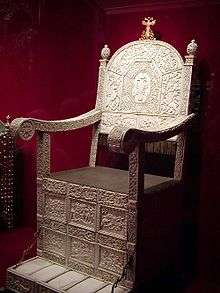
In the later years of Ivan's reign, the southern borders of Muscovy were disturbed by Crimean Tatars. Their main purpose was the capture of slaves.[41] (see also Slavery in the Ottoman Empire.) Khan Devlet I Giray of Crimea repeatedly raided the Moscow region. In 1571, the 40,000-strong Crimean and Turkish army launched a large-scale raid. Due to the ongoing Livonian War, Moscow's garrison was as small as 6,000, and could not even delay the Tatar approach. Unresisted, Devlet devastated unprotected towns and villages around Moscow and caused the 1571 Fire of Moscow. Historians estimate the number of casualties of the fire from 10,000 to as many 80,000 people.
To buy peace from Devlet Giray, Ivan was forced to relinquish his claims on Astrakhan in favor of the Crimean Khanate (although this proposed transfer was only a diplomatic maneuver and was never actually completed). This defeat angered Ivan. Between 1571 and 1572, preparations were made upon his orders. In addition to Zasechnaya cherta, innovative fortifications were set beyond the River Oka that defined the border.
The following year, Devlet launched another raid on Moscow, now with a 120,000-strong[42] horde, equipped with cannons and reinforced by Turkish janissaries. On 26 July 1572, the horde crossed the River Oka near Serpukhov, destroyed the Russian vanguard of 200 noblemen and advanced towards Moscow.
The Russian army, led by Prince Mikhail Vorotynsky, was half the size, estimated at between 60,000–70,000 men; yet it was an experienced streltsi army, equipped with modern firearms and gulyay-gorods. On 30 July the armies clashed near the River Lopasnya in what would be known as the Battle of Molodi, which continued for more than a week. The outcome was a decisive Russian victory. The Crimean horde was defeated so thoroughly that both the Ottoman Sultan and the Crimean khan, his vassal, had to give up their ambitious plans of northward expansion into Russia.
Conquest of Siberia
During Ivan's reign, Russia started a large-scale exploration and colonization of Siberia. In 1555, shortly after the conquest of Kazan, the Siberian khan Yadegar and the Nogai Horde under Khan Ismail pledged their allegiance to Ivan, in hope that he would help them against their opponents. However, Yadegar failed to gather the full sum of tribute he proposed to the tsar, so Ivan did nothing to save his inefficient vassal. in 1563 Yadegar was overthrown and killed by Khan Kuchum, who denied any tribute to Moscow.
In 1558 Ivan gave the Stroganov merchant family the patent for colonising "the abundant region along the Kama River", and in 1574, lands over the Ural Mountains along the rivers Tura and Tobol. They also received permission to build forts along the Ob and Irtysh rivers. Around 1577, the Stroganovs engaged the Cossack leader Yermak Timofeyevich to protect their lands from attacks of the Siberian Khan Kuchum.
In 1580 Yermak started his conquest of Siberia. With some 540 Cossacks, he started to penetrate territories that were tributary to Kuchum. Yermak pressured and persuaded the various family-based tribes to change their loyalties and become tributaries of Russia. Some agreed voluntarily, under better terms than with Kuchum; others were forced. He also established distant forts in the newly conquered lands. The campaign was successful, and the Cossacks managed to defeat the Siberian army in the Battle of Chuvash Cape, but Yermak was still in need for reinforcements. He sent an envoy to Ivan the Terrible, with a message that proclaimed Yermak-conquered Siberia a part of Russia, to the dismay of the Stroganovs, who had planned to keep Siberia for themselves. Ivan agreed to reinforce the Cossacks with his streltsi. Yermak's conquest expanded Ivan's empire to the east and allowed him to style himself "Tsar of Siberia" in the tsar's very last years.
Personal life
Marriages and children
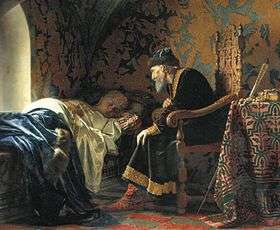
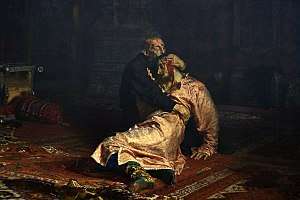
- Anastasia Romanovna (in 1547–1560, death):
- Tsarevna Anna Ivanovna (10 August 1548 – 20 July 1550)
- Tsarevna Maria Ivanovna (17 March 1551 – young)
- Tsarevich Dmitri Ivanovich (October 1552 – 26 June 1553)
- Tsarevich Ivan Ivanovich (28 March 1554 – 19 November 1581)
- Tsarevna Eudoxia Ivanovna (26 February 1556 – June 1558)
- Tsar Feodor I of Russia (31 May 1557 – 6 January 1598)
- Maria Temryukovna (in 1561–1569, death):
- Tsarevich Vasili Ivanovich (21 March 1563 – 3 May 1563)
- Marfa Sobakina (28 October – 13 November 1571, death)
- Anna Koltovskaya (in 1572, sent to monastery). This was the last of his church-authorized weddings. She was later canonized as Saint Daria.
- Anna Vasilchikova (in 1575/76, sent to monastery)
- Vasilisa Melentyeva (concubine in 1575 ?). Possibly fictitious, a 19th-century creation;[43][44] his other "wife" Maria Dolgorukaya (1573) is fictitious.
- Maria Nagaya (since 1580), widow:
- Tsarevich Dmitri Ivanovich (19 October 1582 – 15 May 1591)
In 1581 Ivan beat his pregnant daughter-in-law (Yelena Sheremeteva) for wearing immodest clothing, and this may have caused a miscarriage. His second son, also named Ivan, upon learning of this, engaged in a heated argument with his father, resulting in Ivan's striking his son in the head with his pointed staff, fatally wounding him.[45] This event is depicted in the famous painting by Ilya Repin, Ivan the Terrible and his son Ivan on Friday, 16 November 1581 better known as Ivan the Terrible killing his son.
Arts
Ivan was a poet, a composer of considerable talent, and supported the arts. His Orthodox liturgical hymn, "Stichiron No. 1 in Honor of St. Peter", and fragments of his letters were put into music by Soviet composer Rodion Shchedrin. The recording, the first Soviet-produced CD, was released in 1988, marking the millennium of Christianity in Russia.[46][47]
Epistles
D.S. Mirsky called Ivan "a pamphleteer of genius".[48] These letters are often the only existing source on Ivan's personality and provide crucial information on his reign, but Harvard professor Edward Keenan has argued that these letters are 17th-century forgeries. This contention, however, has not been widely accepted, and most other scholars, such as John Fennell and Ruslan Skrynnikov continued to argue for their authenticity. Recent archival discoveries of 16th-century copies of the letters strengthen the argument for their authenticity.[49][50]
Religion
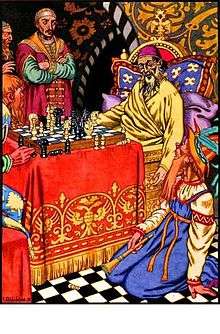
Ivan was a devoted[34] follower of Christian Orthodoxy and placed the most emphasis on defending the divine right of the ruler to unlimited power under God.[51] Some scholars explain the sadistic and brutal deeds of Ivan the Terrible with the religious concepts of the 16th century,[52] which included drowning and roasting people alive or torturing victims with boiling or freezing water, corresponding to the torments of Hell, consistent with Ivan's view of being God's representative on Earth with a sacred right and duty to punish. He may also have been inspired by the model of Archangel Michael with the idea of divine punishment.[52]
Death
Ivan died from a stroke while playing chess with Bogdan Belsky[53] on 28 March [O.S. 18 March] 1584.[53] Upon Ivan's death, the Russian throne was left to his unfit middle son Feodor.[45] Feodor died childless in 1598, ushering in the Time of Troubles.
Appearance
Little is known about Ivan's appearance, as virtually all existing portraits were made after his death and contain uncertain amounts of artist's impression.[1] In 1567, ambassador Daniel Prinz von Buchau described Ivan as follows: "He is tall, stout and full of energy. His eyes are big, observing and restless. His beard is reddish-black, long and thick, but most other hairs on his head are shaved off according to the Russian habits of the time".[45]
According to Ivan Katyryov-Rostovsky, the son-in-law of Michael I of Russia, Ivan had an unpleasant face, with a long and crooked nose. He was tall and athletically built, with broad shoulders and narrow waist.[45]
In 1963, the graves of Ivan and his sons were excavated and examined by Soviet scientists. Chemical and structural analysis of his remains disproved earlier suggestions that Ivan suffered from syphilis, or that he was poisoned by arsenic or strangled. At the time of his death he was 178 cm tall and weighed 85–90 kg. His body was rather asymmetrical and had a large amount of osteophytes uncharacteristic of his age; it also contained excessive concentration of mercury. Researchers concluded that while Ivan was athletically built in his youth, in his last years he had developed various bone diseases and could barely move. They attributed the high mercury content in his body to the use of ointments for joints healing.[1]
Legacy
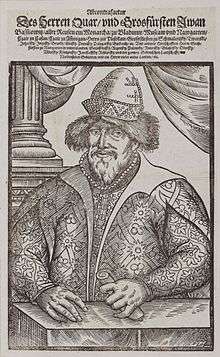
Ivan completely altered Russia's governmental structure, establishing the character of modern Russian political organisation.[54] Ivan's creation of the Oprichnina, answerable only to him, not only afforded him personal protection but curtailed the traditional powers and rights of the boyars.[55] Henceforth, Tsarist autocracy and despotism would lie at the heart of the Russian state.[56] Ivan bypassed the Mestnichestvo system and offered positions of power to his supporters among the minor gentry.[57] The Empire's local administration combined both locally and centrally appointed officials; the system proved durable and practical, and sufficiently flexible to tolerate later modification.[19]
Ivan's expedition against Poland failed at a military level, but it helped extend Russia's trade, political and cultural links with Europe; Peter the Great built on these connections in his bid to make Russia a major European power. At Ivan's death, the empire encompassed the Caspian to the southwest, and Western Siberia to the east. Southwards, his conquests ignited several conflicts with expansionist Turkey, whose territories were thus confined to the Balkans and the Black Sea regions.[58]
Ivan's management of Russia's economy proved disastrous, both in his lifetime and after. He had inherited a government in debt, and in an effort to raise more revenue for his expansionist wars, he instituted a series of increasingly unpopular and burdensome taxes.[59] Successive wars drained Russia of manpower and resources, bringing it "to the brink of ruin".[60] After Ivan's death, his empire's nearly ruined economy contributed to the decline of his own Rurik Dynasty, leading to the "Time of Troubles".
Ivan's notorious outbursts and autocratic whims helped characterise the position of Tsar as one accountable to no earthly authority, only to God.[19] Tsarist absolutism faced few serious challenges until the late 19th century. Ivan's legacy was manipulated by Communist Russia as a potential focus for nationalist pride; his image became closely associated with the personality cult of Joseph Stalin.[61] While early Soviet, Marxist–Leninist historiography "attached greater significance to socio-economic forces than to political history and the role of individuals", Stalin wanted official historians to make Russia's history "comprehensible and accessible" to the populace, with an emphasis on those "great men", such as Ivan, Alexander Nevsky and Peter the Great, who had strengthened and expanded the Russian state.[62] In modern, post-Soviet Russia, a campaign has been run to seek the granting of sainthood to Ivan IV;[63] the Russian Orthodox Church opposed the idea.[64]
Popular culture
- The Soviet filmmaker Sergei Eisenstein made two films based on Ivan's life and reign, Ivan the Terrible. The first part is about Ivan's early years. The second covers the period of his maturity. A third was planned but never completed.
- Conrad Veidt portrayed Ivan the Terrible in Paul Leni's film Waxworks.
- Tsar – a 2009 Russian drama film directed by Pavel Lungin.
- In the film Night at the Museum: Battle of the Smithsonian Ivan was played by Christopher Guest.
- Russka (1991) the novel by Edward Rutherfurd
- Ivan the Terrible is a major character in the Soviet era fiction comedy Ivan Vasilievich: Back to the Future, based on a play by Mikhail Bulgakov. It was one of the most popular films in the Soviet Union in 1973 and sold more than 60 million tickets.[65]
- Ivan appears as a major character in the novel The Ringed Castle (1971), fifth of the six novels in Dorothy Dunnett's historical fiction series, the Lymond Chronicles.
- Ivan was portrayed on BBC Radio 4 by David Threlfall in the radio play Ivan the Terrible: Absolute Power, written by Mike Walker and which was the first play in the first series of Tsar.[66] The play was broadcast on 11 September 2016.
Ancestry
| Ancestors of Ivan the Terrible | ||||||||||||||||||||||||||||||||||||||||||||||||||||||||||||||||||||||||||||||||||||||||||||||||||||||||||||||||||||||||||||||||||||||||||||||||||||||||||||||||||||||||||||||||||||||||||||||||||||||||||||||||||||||||||||||||||||||||||||||||||||||||||||||||||||||||||||||||||||||||||||||||||||||||||||||||||||||||||||||||||||||||||||||||||||||||||||||||||||||||||||||||||||||||||||||||||||||||||||||||||||||||||||||||||||||||||||||||||||||||||||||||||||||||||||||||||||||||||||||||||||||||||||||||||||||||||||||||||||||||||||||||||||||||||||||||||||||||||||||||||||||||||||||||
|---|---|---|---|---|---|---|---|---|---|---|---|---|---|---|---|---|---|---|---|---|---|---|---|---|---|---|---|---|---|---|---|---|---|---|---|---|---|---|---|---|---|---|---|---|---|---|---|---|---|---|---|---|---|---|---|---|---|---|---|---|---|---|---|---|---|---|---|---|---|---|---|---|---|---|---|---|---|---|---|---|---|---|---|---|---|---|---|---|---|---|---|---|---|---|---|---|---|---|---|---|---|---|---|---|---|---|---|---|---|---|---|---|---|---|---|---|---|---|---|---|---|---|---|---|---|---|---|---|---|---|---|---|---|---|---|---|---|---|---|---|---|---|---|---|---|---|---|---|---|---|---|---|---|---|---|---|---|---|---|---|---|---|---|---|---|---|---|---|---|---|---|---|---|---|---|---|---|---|---|---|---|---|---|---|---|---|---|---|---|---|---|---|---|---|---|---|---|---|---|---|---|---|---|---|---|---|---|---|---|---|---|---|---|---|---|---|---|---|---|---|---|---|---|---|---|---|---|---|---|---|---|---|---|---|---|---|---|---|---|---|---|---|---|---|---|---|---|---|---|---|---|---|---|---|---|---|---|---|---|---|---|---|---|---|---|---|---|---|---|---|---|---|---|---|---|---|---|---|---|---|---|---|---|---|---|---|---|---|---|---|---|---|---|---|---|---|---|---|---|---|---|---|---|---|---|---|---|---|---|---|---|---|---|---|---|---|---|---|---|---|---|---|---|---|---|---|---|---|---|---|---|---|---|---|---|---|---|---|---|---|---|---|---|---|---|---|---|---|---|---|---|---|---|---|---|---|---|---|---|---|---|---|---|---|---|---|---|---|---|---|---|---|---|---|---|---|---|---|---|---|---|---|---|---|---|---|---|---|---|---|---|---|---|---|---|---|---|---|---|---|---|---|---|---|---|---|---|---|---|---|---|---|---|---|---|---|---|---|---|---|---|---|---|---|---|---|---|---|---|---|---|---|---|---|---|---|---|---|---|---|---|---|---|---|---|---|---|---|---|---|---|---|---|---|---|---|---|---|---|---|---|---|---|---|---|---|---|---|---|---|---|---|---|---|---|---|---|---|---|---|---|---|---|---|---|---|---|---|---|---|---|---|---|---|---|---|---|---|---|---|---|---|---|---|---|---|---|---|---|---|---|---|---|---|---|---|---|---|---|---|---|---|---|---|---|---|---|---|---|---|---|---|---|---|---|---|---|---|---|---|---|---|---|---|---|---|---|---|---|---|---|---|---|---|---|---|---|---|---|---|---|---|---|---|---|---|---|---|---|---|---|---|---|---|---|---|
| ||||||||||||||||||||||||||||||||||||||||||||||||||||||||||||||||||||||||||||||||||||||||||||||||||||||||||||||||||||||||||||||||||||||||||||||||||||||||||||||||||||||||||||||||||||||||||||||||||||||||||||||||||||||||||||||||||||||||||||||||||||||||||||||||||||||||||||||||||||||||||||||||||||||||||||||||||||||||||||||||||||||||||||||||||||||||||||||||||||||||||||||||||||||||||||||||||||||||||||||||||||||||||||||||||||||||||||||||||||||||||||||||||||||||||||||||||||||||||||||||||||||||||||||||||||||||||||||||||||||||||||||||||||||||||||||||||||||||||||||||||||||||||||||||
In art
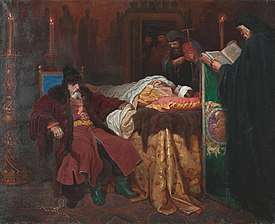 Ivan the Terrible meditating at the deathbed of his son. Ivan's murder of his son brought about the extinction of the Rurik Dynasty and the Time of Troubles. Painting by Vyacheslav Schwarz (1861).
Ivan the Terrible meditating at the deathbed of his son. Ivan's murder of his son brought about the extinction of the Rurik Dynasty and the Time of Troubles. Painting by Vyacheslav Schwarz (1861). Ivan the Terrible, by Sergei Kirillov
Ivan the Terrible, by Sergei Kirillov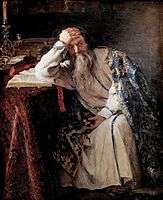 Ivan the Terrible by Klavdiy Lebedev, 1916
Ivan the Terrible by Klavdiy Lebedev, 1916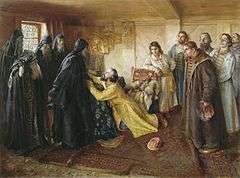 Ivan's repentance: he asks a father superior Kornily of the Pskovo-Pechorsky Monastery to let him take the tonsure at his monastery. Painting by Klavdiy Lebedev, 1898.
Ivan's repentance: he asks a father superior Kornily of the Pskovo-Pechorsky Monastery to let him take the tonsure at his monastery. Painting by Klavdiy Lebedev, 1898..jpg) Ivan the Terrible and his old nanny, by Bogdan (Karl) Venig
Ivan the Terrible and his old nanny, by Bogdan (Karl) Venig.jpg) Ivan the Terrible and souls of his victims, by Mikhail Clodt
Ivan the Terrible and souls of his victims, by Mikhail Clodt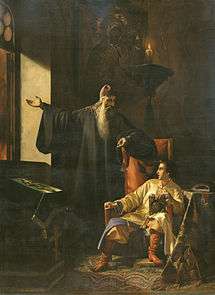 Tsar Ivan the Terrible and the priest Sylvester, 24 June 1547 (oil painting, 1856, by Pavel Pleshanov)
Tsar Ivan the Terrible and the priest Sylvester, 24 June 1547 (oil painting, 1856, by Pavel Pleshanov)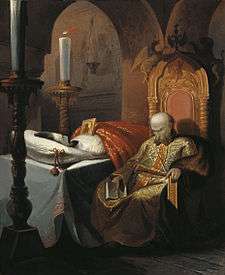 Ivan the Terrible, with the Body of His Son, Whom he has Murdered (1860s), by Nikolay Shustov
Ivan the Terrible, with the Body of His Son, Whom he has Murdered (1860s), by Nikolay Shustov
See also
- Illustrated Chronicle of Ivan the Terrible
- Tsars of Russia family tree
- Tsardom of Russia, history of the Tsardom of Russia
Notes
References
Notes
- 1 2 3 Gerasimov, M. M. (1965). "Документальный портрет Ивана Грозного". Краткие сообщения института археологии Академии наук СССР (in Russian). 100: 139–142.
- ↑ 28 March: This Date in History. Webcitation.org. Retrieved 7 December 2011
- ↑ Shvidkovskiĭ, Dmitriĭ Olegovich (2007) Russian Architecture and the West. Yale University Press. p. 147. ISBN 0300109121.
- ↑ Yanov, p. 208
- ↑ Del Testa, David W. (2001) Government Leaders, Military Rulers and Political Activists. Greenwood Publishing Group. p. 91. ISBN 1573561533
- ↑ Dal, Vladimir, Explanatory Dictionary of the Live Great Russian language, article ГРОЗИТЬ. Available in many editions as well as online, for example at slovardalja.net
- ↑ Jacobsen, C. G. (1993). "Myths, Politics and the Not-so-New World Order". Journal of Peace Research. 30 (3): 241–250. doi:10.1177/0022343393030003001. JSTOR 424804.
- ↑ Noth, Ernst Erich (1941). Books Abroad: An International Literary Quarterly. Vol. 15. University of Oklahoma Press. p. 343. ISSN 0006-7431.
- ↑ McConnell, Frank D. (1979). Storytelling and Mythmaking: Images from Film and Literature. Oxford University Press. ISBN 0-19-502572-5; p. 78: "But Ivan IV, Ivan the Terrible, or as the Russian has it, Ivan groznyi, "Ivan the Magnificent" or "Ivan the Great" is precisely a man who has become a legend"
- ↑ Maureen Perrie & Andrei Pavlov, Ivan the Terrible, Routledge (2014), p. 26
- ↑ Francis Carr, Ivan the Terrible, David & Charles Publishers (1981), p. 61
- ↑ Walter G. Moss, A History of Russia : To 1917, Volume 1, Anthem Press (2003), p. 130
- ↑ Martin, p. 331
- ↑ Pushkareva, N. (1997) Women in Russian History. M.E. Sharpe. pp. 65–67. ISBN 0765632705.
- ↑ Kurbsky, Andrey, Ivan IV, The Correspondence Between Prince A.M. Kurbsky and Tsar Ivan IV, of Russia, 1564-1579, Cambridge University Press, 1955, 275 p., ASIN: B000X81MHO, p.75.
- ↑ http://www.hup.harvard.edu/catalog.php?isbn=9780674181724
- ↑ Martin, p. 377
- ↑ Bogatyrev, p. 245
- 1 2 3 Bogatyrev, p. 263.
- ↑ Paul, Michael C. (2004). "The Military Revolution in Russia 1550–1682". The Journal of Military History. 68 (1): 9–45 [esp. pp. 20–22]. doi:10.1353/jmh.2003.0401.
- ↑ Постник. Great Soviet Encyclopedia
- ↑ Барма и Постник (Постник Яковлев). ecology-mef.narod.ru.
- ↑ Постник Барма – строитель собора Василия Блаженного в Москве и Казанского кремля. russiancity.ru.
- ↑

- Platon Vasilievich Pavlov, On the Historical Significance of the Reign of Boris Godunov (Rus.) (Moscow, 1850)
- Sergyei Mikhailivich Solovev, History of Russia (Rus.) (2nd ed., vols. vii–viii, St. Petersburg, 1897).
- ↑ Madariaga, pp. 176–178
- 1 2 3 Pavlov, Andrei and Perrie, Maureen (2003) Ivan the Terrible (Profiles in Power). Harlow, UK: Longman. pp. 112–113. ISBN 058209948X.
- ↑ Madariaga, pp. 179–80
- ↑ Madariaga, pp. 182–183
- ↑ Madariaga, p. 183; as the tonsure was the distinctive hairstyle of monastic orders, a forcibly "tonsured" boyar was effectively exiled from power by being made to enter a monastic life.
- ↑ Martin, p. 410
- 1 2

- ↑ Ivan the Terrible, Russia, (r.1533–84). Users.erols.com. Retrieved 7 December 2011
- ↑ According to the Third Novgorod Chronicle, the massacre lasted for five weeks. Almost every day 500 or 600 people were killed or drowned.
- 1 2 Hays, Jeffrey. IVAN THE TERRIBLE | Facts and Details.
- ↑ Having investigated the report of Maljuta Skuratov and commemoration lists (sinodiki), R. Skrynnikov considers that the number of victims was 2,000–3,000. (Skrynnikov R. G., "Ivan Grosny", M., AST, 2001)
- ↑ Martin, p. 407.
- ↑ "Russians in London: Government in exile". The Economist. 12 February 2016. Retrieved 12 February 2016.
- ↑ ХОЖДЕНИЕ НА ВОСТОК ГОСТЯ ВАСИЛИЯ ПОЗНЯКОВА С ТОВАРИЩИ (The travels to the Orient by the merchant Vasily Poznyakov and his companions) (in Russian)
- ↑ Russian chronicles record about 40 attacks of Kazan Khans on Russian territories (mainly the regions of Nizhniy Novgorod, Murom, Vyatka, Vladimir, Kostroma and Galich) in the first half of the 16th century. In 1521 the combined forces of Khan Mehmed Giray and his Crimean allies attacked Russia, captured more than 150,000 slaves The Full Collection of the Russian Annals, vol.13, SPb, 1904
- ↑ Janet Martin, Medieval Russia:980-1584, (Cambridge University Press, 1996), p. 356
- ↑ Kizilov, Mikhail (2007). "Slave Trade in the Early Modern Crimea From the Perspective of Christian, Muslim and Jewish Sources". Journal of Early Modern History. 11: 1. doi:10.1163/157006507780385125.
- ↑ Новгородская вторая летопись. Год 7080(1572). ПСРЛ т. III, СПб, 1841
- ↑ Йена, Детлеф (2008). Русские царицы (1547—1918). Moscow, p. 43
- ↑ Сперанский М. Н. (1956) Русские подделки рукописей в начале XIX в. Vol. 5, p. 100
- 1 2 3 4 Zimin, A.A; Khoroshkevich, A.L. (1982). "Отечественные историки о государе Иване IV Грозном". Россия времен Ивана Грозного (in Russian). Moscow. pp. 147–151. Archived from the original on 20 March 2008.
- ↑ "Иван IV Грозный / Родион Константинович Щедрин – Стихиры (Первый отечественный компакт-диск)". intoclassics.net. 9 August 2009.
- ↑ Kuzin, Viktor. "Первый русский компакт-диск". rarity.ru.
- ↑ Mirsky, D.S.; Whitfield, Francis James (1958). "A History of Russian Literature: From Its Beginnings to 1900". ISBN 9780810116795.
- ↑ Keenan, Edward L. (1971) The Kurbskii-Groznyi Apocrypha: the 17th Century Genesis of the "Correspondence" Attributed to Prince A. M. Kurbskii and Tsar Ivan IV. Cambridge, Massachusetts: Harvard University Press
- ↑ Martin, pp. 328–329.
- ↑ "Ivan IV | tsar of Russia". Encyclopedia Britannica.
- 1 2 Perrie, Maureen; Pavlov, Andrei. Ivan the Terrible. Routledge. ISBN 9781317894674.
- 1 2 Waliszewski, Kazimierz; Mary Loyd (1904). Ivan the Terrible. Philadelphia: J.B. Lippincott. pp. 377–78.
- ↑ Yanov, p. 31
- ↑ Yanov, p. 69.
- ↑ Yanov, p. 68.
- ↑ Riasanovsky, Nicholas V., and Mark D. Steinberg (2011). "Russia at the Time of Ivan IV, 1533–1598" in A History of Russia 8th ed. Vol. 1. New York: Oxford University Press, p. 151. ISBN 9780195341973.
- ↑ Shrynnikov, Ruslan G. (1975) "Conclusion", p. 199 in Ivan the Formidable, translated by Hugh F. Graham. Moscow: Academic International.
- ↑ Martin, p. 404.
- ↑ Martin, p. 415.
- ↑ Maureen, Perrie (2001). The Cult of Ivan the Formidable in Stalin's Russia. New York: Palgrava.
- ↑ Perrie, Maureen (1987). The Image of Ivan the Formidable in Russian Folklore. Cambridge, UK: Pitt Building.
- ↑ "Russians Laud Ivan the Not So Formidable; Loose Coalition Presses Orthodox Church to Canonize the Notorious Czar" The Washington Post, 10 November 2003.
- ↑ "Church says nyet to St. Rasputin". UPI NewsTrack. 4 October 2004
- ↑ Leaders of distribution Archived 10 May 2012 at the Wayback Machine.. kinokultura.com (in Russian)
- ↑ Drama, Tsar, Ivan the Terrible: Absolute Power. BBC Radio 4 (17 September 2016). Retrieved on 2016-11-21.
Bibliography
- Bogatyrev, Sergei (2006). "10. Ivan IV (1533–1584)". In Maureen Perrie. The Cambridge History of Russia. Vol. 1: From Early Rus' to 1689. Cambridge Histories Online. doi:10.1017/CHOL9780521812276.011. ISBN 0-521-81227-5.
- Madariaga, Isabel de (2005). Ivan the Terrible. First Tsar of Russia. New Haven; London: Yale University Press. ISBN 0-300-09757-3.
- Martin, Janet (2007). ""Ivan IV the Terrible"". Medieval Russia 980–1584 (2nd ed.). New York: Cambridge University Press. ISBN 0-521-85916-6.
- Yanov, Alexander (1981). The Origins of Autocracy. Los Angeles: University of California Press. ISBN 0-520-04282-4.
General references
- Bobrick, Benson. Ivan the Terrible. Edinburgh: Canongate Books, 1990 (hardcover, ISBN 0-86241-288-9). (Also published as Fearful Majesty)
- Hosking, Geoffrey. Russia and the Russians: A History. Cambridge: Harvard University Press, 2004 (paperback, ISBN 0-674-01114-7).
- Payne, Robert; Romanoff, Nikita. Ivan the Terrible. Lanham, Maryland: Cooper Square Press, 2002 (paperback, ISBN 0-8154-1229-0).
- Troyat, Henri. Ivan the Terrible. New York: Buccaneer Books, 1988 (hardcover, ISBN 0-88029-207-5); London: Phoenix Press, 2001 (paperback, ISBN 1-84212-419-6).
- Ivan IV, World Book Inc, 2000. World Book Encyclopedia.
Further reading
- Cherniavsky, Michael. "Ivan the Terrible as Renaissance Prince", Slavic Review, Vol. 27, No. 2. (Jun. 1968), pp. 195–211.
- Hunt, Priscilla. "Ivan IV's Personal Mythology of Kingship", Slavic Review, Vol. 52, No. 4. (Winter, 1993), pp. 769–809.
- Perrie, Maureen. The Image of Ivan the Terrible in Russian Folklore (Cambridge Studies in Oral and Literate Culture; 14). Cambridge: Cambridge University Press, 1987 (hardcover, ISBN 0-521-33075-0); 2002 (paperback, ISBN 0-521-89100-0).
- Perrie, Maureen. The Cult of Ivan the Terrible in Stalin's Russia (Studies in Russian and Eastern European History and Society) . New York: Palgrave, 2001 (hardcopy, ISBN 0-333-65684-9).
- Platt, Kevin M.F.; Brandenberger, David. "Terribly Romantic, Terribly Progressive, or Terribly Tragic: Rehabilitating Ivan IV under I.V. Stalin", Russian Review, Vol. 58, No. 4. (Oct. 1999), pp. 635–654.
- Isolde Thyrêt, "The Royal Women of Ivan IV's Family and the Meaning of Forced Tonsure," in Anne Walthall (ed), Servants of the Dynasty: Palace Women in World History (Berkeley, Univ. California Press, 2008) (California World History Library, 7), 159–171.
External links
| Wikimedia Commons has media related to Ivan IV of Russia. |
- The throne of Ivan the Terrible
- The holy gospel of Ivan the Terrible
- Ivan the Terrible with videos, images and translations from the Russian Archives and State Museums
Ivan the Terrible Born: 3 September 1530 Died: 28 March 1584 | ||
| Regnal titles | ||
|---|---|---|
| Tsardom created | Tsar of All the Russias 16 January 1547 – 28 March 1584 |
Succeeded by Feodor I |
| Preceded by Vasili III |
Grand Prince of Moscow 3 December 1533 – 16 January 1547 |
Tsardom created |
.svg.png)
.svg.png)
